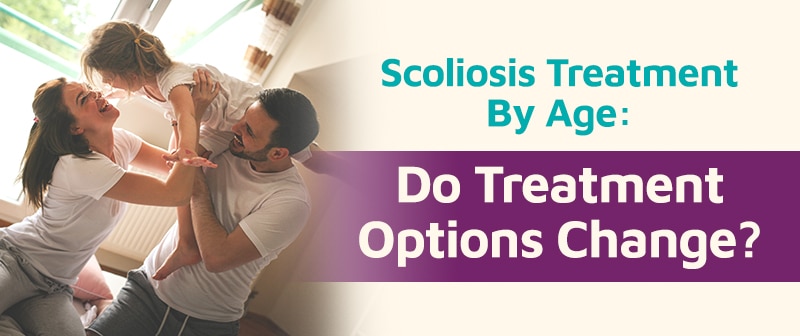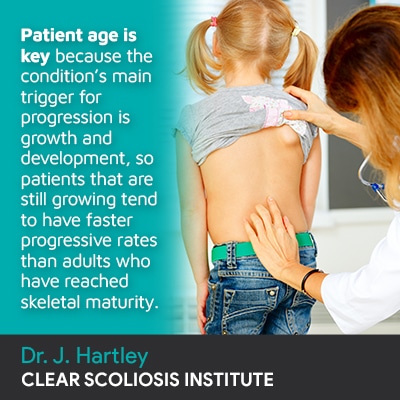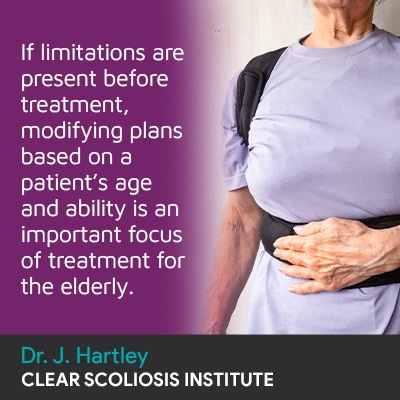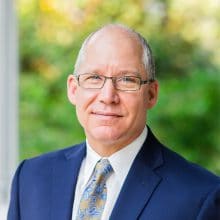
Regardless of patient age, as a progressive condition, being proactive with treatment is key. When it comes to how patient age factors into treatment, we’re talking about different progressive rates, whether or not pain management is needed, and how stable the spine is.
With wide-ranging severity levels and multiple condition types, scoliosis can be a complex condition to treat. Scoliosis affects all ages, and while the goal of treatment is always to reduce and improve a patient’s scoliosis, the focus can shift when treating patients of different ages.
Before getting to the specifics of scoliosis treatment by age, let’s first talk generally about some key condition characteristics.
While scoliosis has been around for hundreds of years, there is still a lot we don’t understand about the condition, particularly in terms of its causation.
When a person is diagnosed with scoliosis, they have an unnatural lateral (side-to-side) spinal curve that also rotates, and has a minimum Cobb angle measurement of 10 degrees.
A patient’s Cobb angle is a key condition characteristic as it indicates how far out of alignment a scoliotic spine is, while also classifying conditions by severity:
A patient’s condition severity is an important factor when it comes to shaping effective treatment plans, and mild to moderate and severe is also the condition’s progressive line.
Scoliosis is a progressive condition, which means its nature is to worsen over time, so a focus of treatment is counteracting the condition’s progressive nature, and when it comes to progression, patient age is important.

Let’s break down some of the differences in treatment for children, adolescents, adults, and the elderly with scoliosis.
When it comes to treating scoliosis in children, we’re talking about young children who have not yet had their first major adolescent growth spurt.
Scoliosis in children should be taken seriously as growth can make conditions progress quickly.
When an infant is born with scoliosis, this is congenital scoliosis, and it’s caused by a malformation within the spine, such as vertebrae being misshapen, or multiple vertebrae failing to separate and instead becoming fused together.
Congenital scoliosis is a rare form, affecting approximately 1 in 10,000, and congenital scoliosis can be accompanied by other bodily malformations, so these patients need to be fully assessed and monitored carefully.
Infantile idiopathic scoliosis can develop in infants around the age of 6 months, and unlike congenital scoliosis, they aren’t born with the condition due to a malformed spine.
In some cases of infantile scoliosis, the curve will resolve on its own, but it’s impossible to predict which cases will resolve, and which will progress with time and growth, and those that don’t resolve on their own, are likely to continue progressing throughout childhood.
Treatment for patients of such a young age has obvious challenges, so monitoring closely, modifying treatment, EDF casting (elongation, de-rotation/flexion) when appropriate, and consistent management is important.
Early-onset juvenile scoliosis refers to patients between the ages of 3 and 10, and as this age group has so much growth yet to go through, and haven’t had their first adolescent growth spurt, these cases can progress into adulthood, if left untreated.
If detected early and proactive treatment is applied, achieving a significant curvature reduction before entering into the stage of puberty, characterized by unpredictable growth spurts, can be highly beneficial.
Conservative chiropractic-centered treatment has shown positive results in treating early-onset juvenile scoliosis by preventing progression and helping patients avoid surgery later in life; while this requires a lot of hard work and commitment both from the patient and their support system, its benefits can far outweigh the challenges.
When it comes to scoliosis in children, a focus of treatment is working towards counteracting the constant trigger of growth, so the goal is a significant curvature reduction, on a structural level, and if a reduction is achieved, the focus shifts to holding it there, despite growth, and increasing core strength so the spine is supported by strong surrounding muscles
Now that we’ve addressed how to treat scoliosis in young children, let’s move on to the condition’s most-prevalent form: adolescent idiopathic scoliosis (AIS).
Adolescent idiopathic scoliosis develops between the ages of 10 and 18.
Idiopathic means we don’t fully understand why the condition has developed; it’s thought that AIS is more multifactorial, meaning caused by a combination of variables that can vary from patient to patient, but we most certainly know how to treat it.
This age group, due to pubescent growth spurts, is at risk for rapid-phase progression, so again, being proactive with treatment is key.
The focus of a conservative chiropractic-centered treatment approach is to start treatment as close to the time of diagnosis as possible in the best interest of preventing progression, increasing symptoms, and the need for invasive treatment in the future.
An important condition characteristic to understand, especially when it comes to treatment efficacy, is that scoliosis gets more complex to treat as it progresses.
As a scoliotic curve progresses, this means it’s getting larger, and that means the condition’s uneven forces are also increasing, as are its effects on the body.
With progression, the spine gets increasingly rigid, making it less responsive to treatment, and the body gets more used to the unnatural spinal curve’s presence; when treatment is started while scoliosis is mild, the spine is more flexible, and treatment success is more likely.
The main focus of adolescent idiopathic scoliosis treatment is to achieve a significant curvature reduction as this addresses the condition’s underlying structural nature; this is worked towards through a variety of chiropractic techniques and adjustments that reposition the most-tilted vertebrae at the apex of the scoliotic curve.
Addressing areas of vertebral subluxation means realigning the spine, restoring as much of its natural curves as possible, and improving its overall health and biomechanics.
Using physical therapy and a variety of scoliosis-specific exercises (SSEs) can also help with increasing core strength for optimal spinal support, addressing muscle imbalance, postural remodeling, and improving brain-body communication.
Corrective bracing, like the ScoliBrace is often a part of treatment for adolescents as it can help augment corrective results achieved through other disciplines by pushing the spine into a corrective position.
Custom-prescribed home exercises are also recommended to further stabilize and rehabilitate the spine.
When it comes to treating scoliosis in adults, the goal shifts slightly, and while curvature reductions are always a focus, rather than a significant reduction, oftentimes, the goal is to reduce a curvature back to where it was prior to becoming painful.
With adults, there is also natural age-related spinal degeneration to deal with, and a spine that’s unbalanced due to the development of an unnatural spinal curve is going to degenerate at a faster rate.
Through a conservative chiropractic-centered treatment approach, adults can also experience improvement, and a focus of treatment in adults, that’s not a common part of scoliosis treatment in children, is pain management.
As mentioned earlier, once scoliosis becomes compressive in adulthood, the spine and its surroundings, is vulnerable to compression, which is why scoliosis pain is so different for adults, than in younger patients, and why pain management is a focus of adult scoliosis treatment, but not scoliosis treatment in children.
With adults, precise and gentle chiropractic adjustments can help adjust tilted vertebrae, and in some adult patients whose conditions have progressed significantly while left untreated, work has to be done before starting treatment to restore a baseline level of spinal flexibility (remember, spinal rigidity increases with progression) to make the spine more responsive, and to be able to perform beneficial exercises/stretches as part of physical therapy.
With scoliosis treatment for adults, the progressive trigger of growth is removed, which can mean we have more time to craft a customized and effective treatment plan, so counteracting progression is not such a focus, while pain management, preserving spinal function, and stabilizing the spine is.
When used for adults, corrective bracing is more about stabilization and support for short-term pain relief.
Elderly patients with scoliosis are faced with a number of challenges, and even if a patient was to undergo surgery, the risks of invasive spinal surgery only increase with age, and in addition, spinal fusion is known to weaken the spine and limits its function: something elderly patients are already facing due to age.
Conservative chiropractic-centered treatment works towards making the spine more functional to preserve ability and make improvements to quality of life.

Scoliosis treatment by age is an interesting topic; while the goals of treatment are similar, the focus can change somewhat, and patient age is a key factor when it comes to progression and whether or not pain management is necessary.
As a CLEAR-certified scoliosis chiropractor, I closely follow the CLEAR Scoliosis Institute’s treatment protocols for patients of all ages.
For babies born with scoliosis, we’re talking about congenital scoliosis, and for infants who develop scoliosis not related to a bone malformation present at birth, we’re talking about infantile idiopathic scoliosis.
For such a young age group, treatment needs to be modified and scoliosis-specific therapy and/or casting, when appropriate, are potential treatment options for infants.
When talking about children between the age of 3 and 10, we’re talking about early-onset juvenile scoliosis, and because growth is the condition’s trigger for progression, this age group is at risk for scoliosis progression well into the adult years, if left untreated; treatment options include condition-specific chiropractic care and physical therapy.
With adolescent idiopathic scoliosis, we’re talking about the condition’s most-prevalent form diagnosed between the ages of 10 and 18, and again, because of growth throughout puberty, the goal is to achieve a significant curvature reduction despite the constant trigger of growth, increase core strength for spinal support, corrective bracing, and custom-prescribed home exercises to further stabilize/rehabilitate the spine.
When it comes to treating scoliosis in adults, as the condition becomes compressive once skeletal maturity has been reached, pain management can be an important focus of treatment, as can reducing a curve back to where it was prior to becoming painful, and further stabilizing the spine.
For elderly patients with scoliosis, the focus is on pain management, preserving spinal function, and making improvements to overall quality of life, rather than a significant curvature reduction, which becomes more unlikely as the spine is exposed to increasing levels of age-related deterioration.

CLEAR provides a unique and innovative way of understanding scoliosis. Sign up to receive facts and information you won’t find anywhere else.
